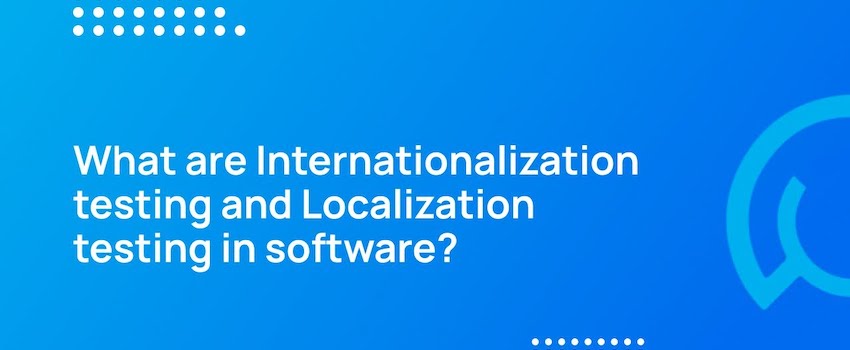Not long ago, one of our enterprise clients approached CredibleSoft with what seemed like a straightforward problem. Their SaaS product worked beautifully in the US, but adoption in Europe and Asia was disappointing. After investigating, we realized the problem was not with functionality, but with localization testing and internationalization testing. This highlighted the importance of comprehensive software testing services that cover global readiness and user experience across multiple regions.
Date formats were incorrect, Arabic text did not render properly, currencies defaulted to USD, and even cultural nuances were off. In short, the product felt foreign. This is a textbook case of how software that ignores localization testing in software risks alienating global users, even if it is technically robust.
In this article, I’ll share how we approach localization testing and internationalization testing for global apps, including best practices, checklists, tool recommendations, pitfalls to avoid, and real-world case studies. You’ll also learn how to measure the effectiveness of your localization testing efforts using key QA metrics, ensuring every global rollout delivers consistent quality. If you’re building or scaling for international markets, this guide will help you deliver products that feel native in every geography.
What Is Localization Testing vs Internationalization Testing in Software?
Many leaders confuse the two, so let’s set the record straight on the difference between localization and internationalization testing.

-
- Internationalization (i18n): Building your software in a way that it can support multiple languages and regional formats without heavy redesign. For example, storing all text in Unicode instead of ASCII so your product can handle Chinese, Japanese, or Arabic characters.
- Localization (l10n): Adapting your product for a specific market. This includes translation, local payment gateways, legal disclaimers, and cultural adjustments. For instance, changing “$10” to “₹800” for Indian users.
Think of i18n as laying the foundation during development, while l10n is the finishing work that makes your product market-ready. Both require rigorous testing.
Why Localization & Internationalization Testing Are Critical in 2026
The importance of localization testing cannot be overstated. Global software adoption is exploding. Gartner reports that by 2027, more than 70% of SaaS revenue for leading providers will come from outside their home markets. Yet, products that ignore localization testing best practices consistently underperform in international markets.
Here’s why internationalization testing is important:
-
- User Trust & Adoption: Users abandon apps that “feel foreign” within minutes. If your product cannot handle their local language, currency, or input method, they won’t trust it.
- Compliance Risks: Many regions have laws on labeling, consent, accessibility, and disclaimers in local languages. Therefore, failing localization testing can result in legal penalties.
- Competitive Advantage: Global-first startups gain an edge over incumbents stuck with legacy systems that were never internationalized.
- Operational Cost Savings: Fixing i18n issues early is far cheaper than patching them post-release when hundreds of users have already flagged bugs.
Common Localization Testing Challenges and Pitfalls to Avoid
At CredibleSoft, we have tested products for clients in the US, UK, India, Japan, and the Middle East. Based on my two decades of experience leading global QA projects, here are the most frequent localization testing challenges in software development:
FIND OUT: How to Do Accessibility Testing: Tools, Checklists & Common Mistakes
-
- Hardcoded Strings: Developers hardcode English text into the application. This makes translation painful and error-prone.
- Unicode Failures: Applications that cannot handle characters from Asian or RTL (Right-to-Left) languages.
- RTL Layout Issues: UIs that completely break when switched to Arabic or Hebrew.
- Formatting Confusion: Misinterpreted dates (05/06/2026 could mean May 6 or June 5), phone numbers, and currency formats.
- Cultural Gaffes: Icons, colors, or examples that unintentionally confuse or offend local users.
- Testing with Only English Data: QA teams often skip testing with actual multilingual data, missing real-world issues.
Best Practices for Effective Internationalization (i18n) and Localization (l10n) Testing
Here are the software localization best practices 2026 we recommend and apply at CredibleSoft.
1. Planning Globalization Testing Early in the Development Lifecycle
It’s important to follow early internationalization testing best practices by involving QA engineers in architecture discussions and planning locale support before writing any code.
-
- Include QA engineers in architecture discussions.
- Ensure your DB, APIs, and UI frameworks support Unicode.
- Plan for locale support before writing a single line of code.
2. Centralized Resource Files for String Management in Localization Testing
Using string externalization in localization testing ensures all translatable text is stored in resource files instead of being hard-coded, making updates and pseudo-localization validation much easier.
-
- Store all translatable text in resource files (e.g.,
.po,.resx,.xliff). - Never embed text directly in code.
- Validate with pseudo-localization to catch spacing or truncation issues.
- Store all translatable text in resource files (e.g.,
3. Automating Localization Testing Across Multiple Locales
Leverage automated localization testing tools like Selenium or Cypress integrated with localized test data to run CI/CD pipelines and catch UI regressions efficiently. Additionally, consider integrating QA automation into your i18n and l10n testing pipeline to streamline testing across multiple locales while maintaining high accuracy and consistency.
-
- Integrate Selenium or Cypress with localization test data.
- Run automated builds in multiple locales as part of CI/CD pipelines.
- Use snapshot testing to detect UI regressions.
4. Simulating Real-World Multilingual User Scenarios
Apply real-world software localization testing examples by testing Japanese, Arabic, French, and Hindi data sets and validating inputs such as IBANs, postal codes, and local phone formats.
-
- Test with Japanese, Arabic, French, and Hindi data sets.
- Validate inputs like IBAN, postcodes, and local phone formats.
- Conduct exploratory testing with native speakers, not just automation.
5. Accessibility and Localization Testing Together
Consider accessibility in localization testing to ensure that screen readers, voice inputs, and other assistive technologies work seamlessly across all supported languages.
-
- Ensure screen readers and assistive tools work in local languages.
- Test voice inputs in multilingual contexts.
- Accessibility overlaps with localization; hence, we need to treat them together, and not separately.
Step-by-Step Localization Testing Checklist for QA Teams
Here’s a localization testing checklist for QA teams you can adapt:
FIND OUT: Remote IT Staff Augmentation vs On-Site Outsourcing: The Clear Winner in 2026
-
Environment Setup
- Verify Unicode support in backend and UI.
- Enable pseudo-localization.
- Load test language packs.
-
Functional Testing
- Validate translations in context.
- Confirm correct currency, date, and time formats.
- Check input/output handling for multilingual content.
-
UI/UX Testing
- Confirm text expansion/shrinkage does not break UI.
- Validate RTL layouts.
- Check font compatibility.
-
Cultural/Legal Testing
- Ensure compliance with local disclaimers.
- Validate color schemes, imagery, and symbols.
-
Performance Testing
- Validate API response times with multilingual payloads.
- Check mobile vs desktop performance across locales.
Tools for Localization and Internationalization Testing in Global Software Projects
Choosing the right best localization testing tools 2026 is critical. Having tested dozens of enterprise projects, here are the top localization and internationalization testing tools I recommend:
-
- Globalyzer: Scans code for i18n readiness.
- Crowdin / Transifex: Cloud-based localization management.
- Xbench: QA tool for consistency in translations.
- Selenium + WebDriver: Automates locale-based UI tests.
- Microsoft Pseudo-Localization: Simulates translations to catch expansion issues.
In practice, no single tool covers it all. In most outsourcing projects, we combine multiple tools. We often combine Crowdin for translation workflow, Selenium for functional testing, and custom Python scripts for test data validation.
Localization and Internationalization in Outsourcing Projects: Hard Lessons Learned
From my experience leading global software projects at CredibleSoft, I’ve seen that outsourcing localization and internationalization testing is trickier than most teams anticipate. Even highly skilled offshore developers can overlook critical issues if i18n and l10n are not integrated from the start. Here are two hard lessons we’ve learned from real projects:
Lesson 1: Plan Internationalization Early
In one e-commerce project outsourced across multiple countries, we discovered hardcoded English strings, broken RTL layouts, and poor Unicode support only during late-stage testing. Retrofitting i18n at that stage was costly and time-consuming. The takeaway: require all outsourced teams to implement globalization-first development and integrate localization testing from day one.
Lesson 2: Combine Automation with Human Validation
In a fintech app targeting the Middle East, automated RTL and formatting tests passed perfectly, yet user testing revealed text truncation and cultural inconsistencies. Automated tools alone cannot catch linguistic nuances or cultural misalignment. The lesson: always combine automation with native-language manual QA to ensure the product feels local in every market.
Case Study: How CredibleSoft Helped a FinTech SaaS Scale Globally with Localization Testing
Here’s a localization testing case study in software outsourcing. One of our clients, a US-based fintech SaaS provider, wanted to expand into India, Japan, and the Middle East. Their product was not internationalized properly, e.g. all amounts defaulted to USD, Arabic layouts broke, and their payment gateway only supported US formats.
Our QA team implemented a comprehensive i18n and l10n testing strategy:
-
- Refactored hardcoded strings into resource files.
- Introduced multi-currency and locale-based formats.
- Automated RTL testing.
- Conducted manual reviews with native testers.
As a result, their adoption rates in target markets doubled within three months. Evidently, localization testing literally unlocked millions in new revenue.
Emerging Trends in Internationalization (i18n) and Localization (l10n) Testing
Looking ahead, here’s the future of localization testing in DevOps and CI/CD:
FIND OUT: Why Online Casino Game Testing in 2026 Demands a Hybrid QA Mindset
-
- AI-Driven Localization: Neural machine translation + human QA.
- Continuous Globalization Testing: Automated globalization checks in every sprint.
- Voice & Chatbot Localization Testing: Crucial as conversational AI adoption grows.
- Stricter Compliance Checks: Especially with EU’s Digital Markets Act and Asian data privacy laws.
Misconceptions About Localization Testing That Can Cost You Growth
Here are common myths about localization testing we encounter:
-
- “Google Translate is Enough”: Machine translation cannot handle context, tone, or culture.
- “Only UI Needs Localization”: Error messages, logs, notifications, and documentation also matter.
- “We’ll Add Localization Later”: Retrofitting globalization into a live product costs 5–10x more.
Conclusion: Why You Need Localization & Internationalization Testing Experts
The reality is simple. Global software localization testing services are now essential to adoption, compliance, and trust. Companies that embrace i18n and l10n testing early scale faster and more profitably. When done right, they ensure your software feels native, compliant, and trustworthy in every market. When done poorly, they alienate users and burn revenue opportunities.
At CredibleSoft, we have built a reputation for helping companies expand globally by providing end-to-end localization testing services, from i18n readiness assessments to full l10n automation frameworks. Moreover, our teams have worked with Fortune 500 clients and startups alike, delivering scalable, global-ready solutions.
If you’re preparing to scale globally, schedule a meeting with us. Let’s discuss your localization testing challenges and design a solution that ensures your software feels native, everywhere.
About the Author: Debasis Pradhan is the Founder and CEO of CredibleSoft, a global leader in software QA and development. With over 20 years of hands-on experience in test automation, software quality engineering, and digital transformation, he is known for his unwavering commitment to delivering enterprise-grade software solutions with precision and reliability. 🔔 Follow Deb on LinkedIn





